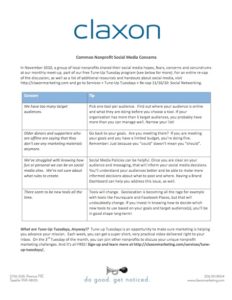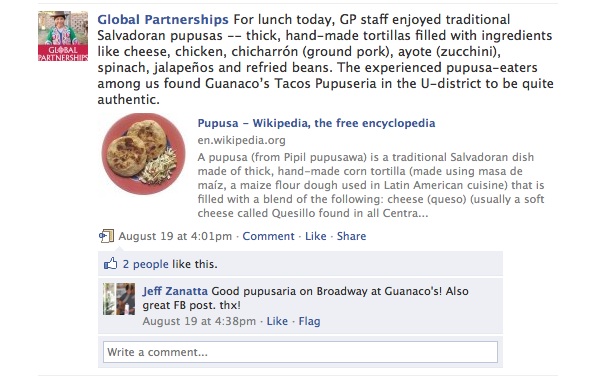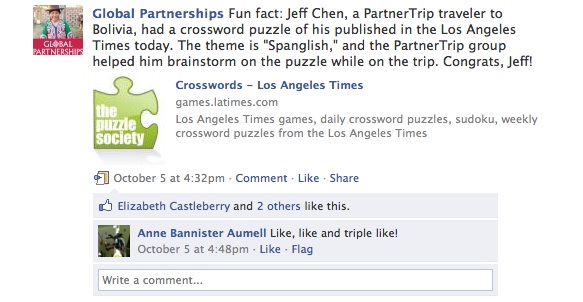 Every once in awhile, you come across an organization and you think: “Dang, they’ve got it going on!” One Day’s Wages, Not for Sale, and the Surfrider Foundation all come to mind. (And keep your eye on a child’s right if you want to see some serious awesomeness…)
Every once in awhile, you come across an organization and you think: “Dang, they’ve got it going on!” One Day’s Wages, Not for Sale, and the Surfrider Foundation all come to mind. (And keep your eye on a child’s right if you want to see some serious awesomeness…)
Seattle-based Jolkona is one of those can’t-take-my-eye-off-of-you organizations. And Laura Kimball, their Director of Communications & Social Media, elevates “social media goodness” to new levels. So I asked if she’d be willing to tell us how Jolkona has used social media to go from relative obscurity to can’t-be-missed powerhouse in such a short period of time.
Here are her top tips:
- DO be human: This isn’t a new piece of advice, per se, but Laura and Jolkona show you how to do it on a platform like Twitter, which many think of as a glorified spambot fueled by ego-maniacal dolts.
- DO get management genuinely on-board. Again, we’ve heard this before, but Laura explained how. Position it as an extension of your other efforts, as a logical extension of existing conversations, instead of New, Shiny, Possibly Distracting thing. If you’re meeting resistance, try something small and show the results. Make it easy for them to see how it relates to organizational goals and invite them into the conversation.
- DO measure. Laura first joined Jolkona as a volunteer. She spent six months trying, tracking, and bench marking. Then she knew what worked and what didn’t. Which topics got the most comments on their Facebook page? Which Tweets sparked interest? Which blog posts got people excited? It’s not enough to have a bunch of fans and followers–engagement drives action which leads, eventually, to results (whatever that means for your organization). Measure early and often.
- DO train volunteers well. It’s tempting to bring on volunteers and expect that they’ll just handle all the social media, liberating you to do other tasks. Laura explained that it doesn’t work that way. Her advice? “Make sure they’re social media savvy. This is easy to figure out because you can follow them on Twitter, Facebook, etc. You can tell if they genuinely love social media.” Once you’ve found a volunteer who is enthusiastic about social media AND your mission, plan on some QT. “Sit side by side with them at first. Explain to them why you use certain words and not others. Share your philosophy. For instance, Jolkona will never use .@ to get into someone’s stream. We care about conversations, not getting noticed. These nuances are what create your on-line personality and that reflects your values. Volunteers shouldn’t have to guess that stuff. Take the time to train them.”
- DO create a social media persona. Are you a 26 year old music-crazy tech geek or a 57 year old gardening fiend? This informs both which channels you chose and how you act when you’re there. The persona can be used on-line and off to bring consistency across platforms.
- DO give people trust, access, empowerment, autonomy and accountability if you ask them to contribute to your social media efforts. Laura uses these five elements as a filter. “When something isn’t going well, it’s usually because one of these isn’t happening,” Laura explains matter-of-factly. “And so we fix it.”
- DO play! “No one has this all figured out. That’s what makes it fun. Try stuff. Social media is very forgiving. If you mess up, say so, and move on,” Laura counsels.
When I asked Laura what the biggest challenge she’s faced so far has been, she laughed and said, “Giving up control of Jolkona’s Twitter handle. Since it had been me from the beginning, it was scary to open it up. But it’s going great! It had to happen.”
A big THANK YOU to Laura for giving us access to her great, big brain. Check out Jolkon’s site for a serious dose of inspiration.
Tell us: In your social media experiments, what have you tried that has worked well or totally flopped?
 We had a blast at the
We had a blast at the 









 Integrating social media into your marketing mix can be daunting. So many options, so little time! In an effort to save you time and keep you sane, we’ve created the following six step process and actionable item checklists for the most popular tools.
Integrating social media into your marketing mix can be daunting. So many options, so little time! In an effort to save you time and keep you sane, we’ve created the following six step process and actionable item checklists for the most popular tools.
